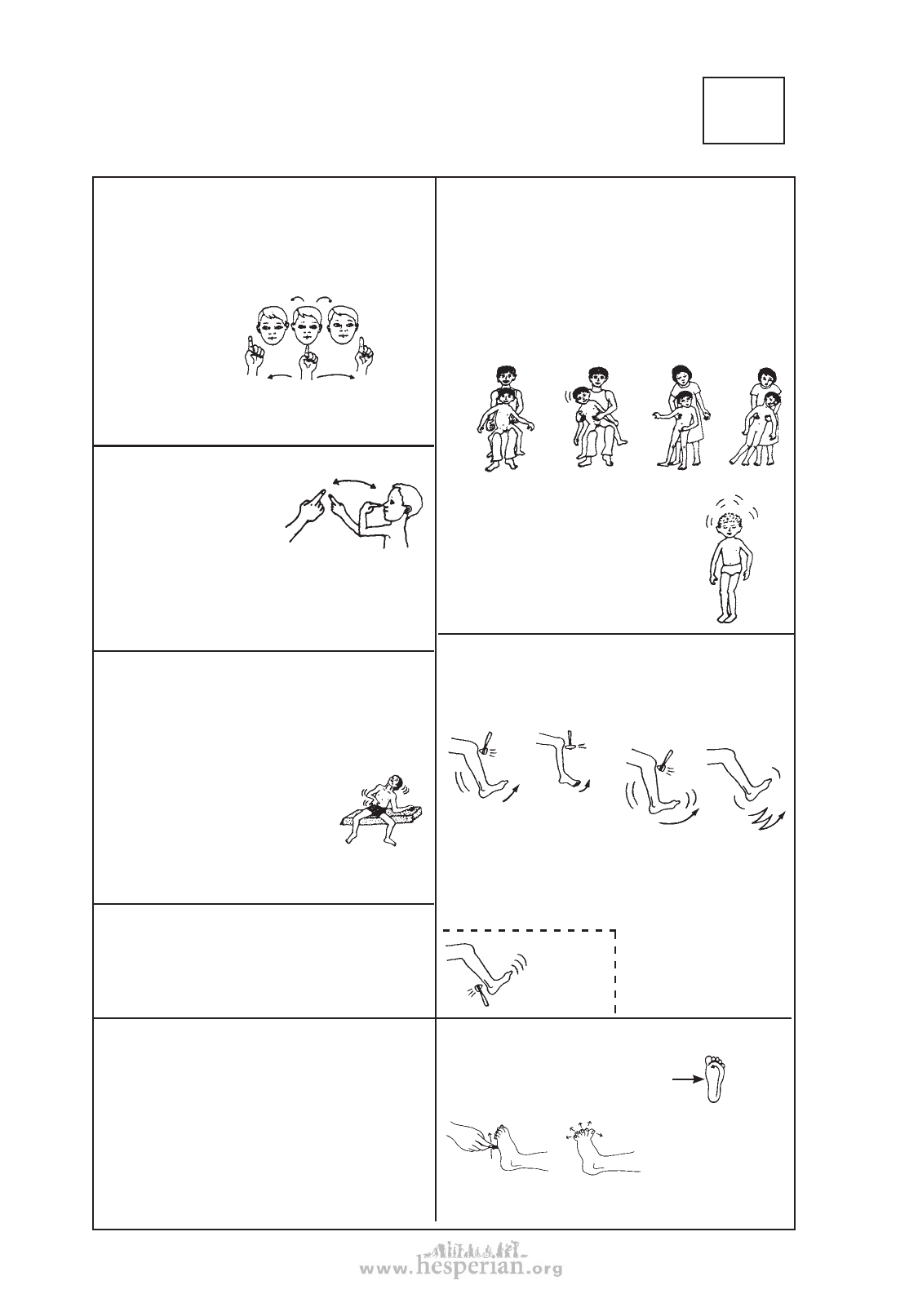
40 chapter 4
RECORD SHEET: ADDITIONAL TESTS AND OBSERVATIONS OF THE
NERVOUS SYSTEM
These tests are often not needed but may sometimes be useful when you are not
sure if a child has brain damage. For other signs of brain damage, see Chapter 9
on Cerebral Palsy. For tests of seeing and hearing, see p. 447 to 454.
RECORD
SHEET
3
Eye movement
Balance
__ eyes jerk, flutter, or roll up unexpectedly and
repeatedly (brain damage, possible epilepsy—
p. 233)
__ one eye looks in a different direction or moves
differently from the other (possible brain damage)
__ Move finger or toy
in front of eyes
from side to side
and up and down.
__ eyes follow
smoothly (normal)
__ eyes follow in jumps or jerks (possible brain
damage)
With the child in a sitting or standing position, gently
rock or push him off balance.
__ CHILD DOES NOT TRY TO KEEP FROM FALLING
(poor balance—sign of brain damage in child over 1 year)
__ CHILD TRIES NOT TO FALL by putting out his hands (fair
balance)
__ CHILD KEEPS FROM FALLING by correcting body position
(good balance)
GOOD
POOR
GOOD
POOR
Eye to hand coordination
__ moves finger from nose
to object and back again
almost without error—
with eyes open, and also
closed (normal)
__ misses or has difficulty
with eyes open (poor
coordination, poor balance,
or loss of position sense)
__ has much more
difficulty with
eyes closed
(loss of position
sense)
Body movements
__ awkwardness or difficulty in controlling
movements
__ sudden or rhythmic uncontrolled movements
__ parts of body twist or move strangely when child
tries to move, reach, walk, speak, or do certain
things
(All these may be signs of brain damage;
see Chapter 9.)
Details of any of the above: _________________________
__________________________________________________
__________________________________________________
__________________________________________________
Seizures of different kinds (See Chapter 29.)
__ sudden loss of consciousness with strange
movements,
__ brief periods of strange movements or positions,
__ blank stares,_ ___ eye fluttering,____ twitching.
Developmental delay: Is the child unable to do
many different things that others her age can do?
Which? (See Chapter 34.)
__ head control
__ sucking
__ use of hands
__ eating
__ rolling
__ creeping and crawling
__ playing
__ communication or
__ sitting
__ standing and walking
speech
__ behavior
__ self-care activities
Balance test for the older, more stable child
Have child stand with feet together.
__ balance difficulty with eyes open—may be
brain damage (or muscle-joint problem)
__ balance difficulty much greater with
eyes closed (probably nervous system
damage)
‘Knee jerks’ and other ‘muscle jump’ reflexes
With the leg relaxed and partly bent, tap the cord
just below the knee cap.
NORMAL
REDUCED
OVER
ACTIVE
KEEPS
JUMPING
The knee
jumps a
little.
The leg moves
very little or
not at all.
Typical of
polio, muscular
dystrophy, and
other floppy
paralyses.
You can also
tap the heel
cord and other
cords near
joint.
A slight tap
causes a
One tap
big jump.
causes the
Typical of
limb to jerk
spasticity
many times.
from cerebral Happens
palsy, spinal with spinal
cord injury,
cord injury
and other brain and some
or spinal cord cerebral
damage.
palsy.
Great toe reflex
Stroke the foot toward the toe with a
somewhat pointed object (like a pen).
NORMAL
NOT NORMAL
(in a child over 2)
toes bend down
toes bend up
and spread
This is a sign of
brain or spinal
cord damage
(Babinski’s sign).
May occur in
a normal child
under 2 years.
Disabled village Children